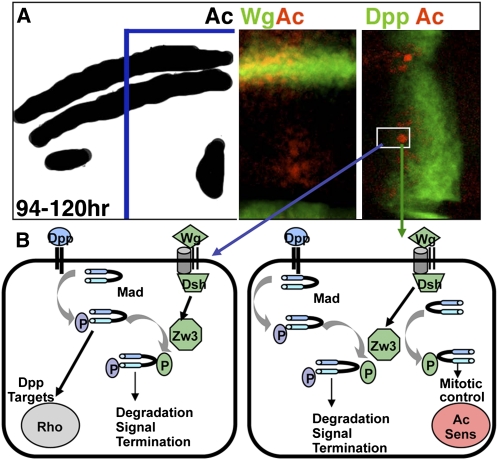Figure 7—
Model of an unconventional Wg pathway leading to Zw3-phosphorylated Mad activity in non-SOP and SOP cells within the anterior–dorsal quadrant of the wing. (A) Schematic of the anterior–dorsal quadrant of a late larval wing disk displaying Ac expression. By this time, Wg activation of Ac has defined the proneural prepattern, and Dpp activation of spalt and omb has specified vein precursor cells. The outlined section of the margin and L3 sensilla region is shown as two confocal stacks depicting Wg-lacZ and Ac (left) and Dpp-lacZ and Ac (right). Two cells are boxed: a cell expressing high levels of Ac due to feedback from Sens that will become an L3 sensilla SOP (right) and presumably an L3 vein precursor (left) that does not express Ac. (B) Schematic of events occurring within the L3 vein precursor (left) and the L3 SOP sensilla precursor (right). Dpp does not play a primary role in L3 vein specification, but it is nonetheless required upstream of rhomboid for proper L3 vein formation (Gomez-Skarmeta and Modolell 1996; Biehs et al. 1998). In the L3 vein precursor (left) that does not express Ac or Sens, Wg-dependent Zw3 phosphorylation of Receptor-phosphorylated Mad leads to degradation and the termination of this round of Dpp signaling. Zw3 phosphorylation of nonphosphorylated Mad, if it occurs here, appears to be inconsequential on the basis of the MGM wing phenotype. In the L3 sensilla SOP that expresses Ac and Sens, Wg-dependent Zw3 phosphorylation of nonphosphorylated Mad leads to nuclear accumulation and the restriction of self-renewing mitosis. Zw3 phosphorylation of Receptor-phosphorylated Mad, if it occurs here, may be among the mechanisms used to render these cells nonresponsive to Dpp.

